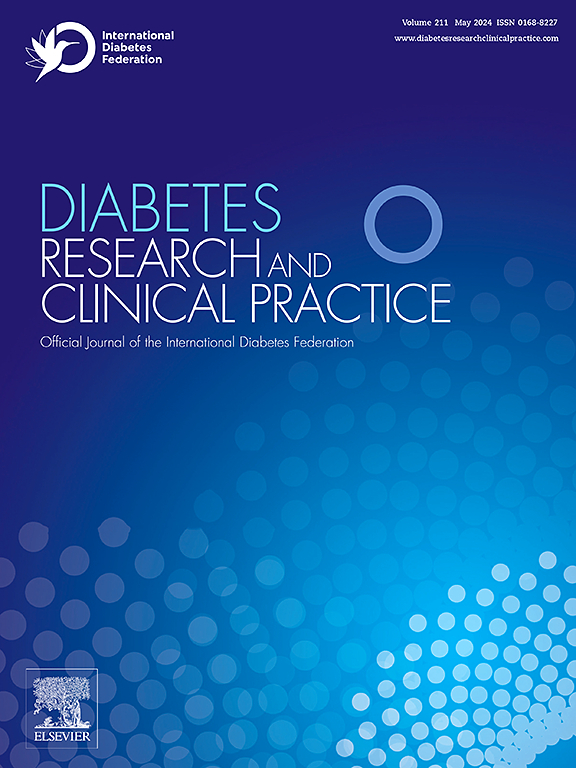基于生物标志物预测糖尿病视网膜病变:分类和回归树模型。
IF 6.1
3区 医学
Q1 ENDOCRINOLOGY & METABOLISM
引用次数: 0
摘要
目的:选择分类回归树(CART)模型作为分析工具,识别评估糖尿病视网膜病变(DR)危险因素的临床指标,确定与DR相关的关键危险因素。方法:本研究共纳入781例糖尿病(DM)患者,其中糖尿病视网膜病变(DR)患者395例,非糖尿病视网膜病变患者386例。采用单因素和多因素logistic回归分析来评估dr的危险因素。此外,采用机器学习方法,CART模型来识别生物标志物的高阶交互作用并预测dr。结果:在96个临床试验指标中,最终确定了11个最关键的指标。基于这11个指标的CART模型分析显示,当尿肌酐(Ucr)≥127.75 mg/dl和皮质醇 ≥ 318.8 µg/l发生在DM患者时,DR的患病率为100 %,即使Ucr 。结论:基于CART模型分析,常规血清生化标志物如Ucr、皮质醇和CRP及其各自的阈值已被确定为潜在有用的识别与DR患病率不同的DR相关的危险因素。这些发现可为临床医生初步评估DR的严重程度提供有用的参考。本文章由计算机程序翻译,如有差异,请以英文原文为准。
Predicting diabetic retinopathy based on biomarkers: Classification and regression tree models
Objective
We choose the classification and regression tree (CART) model as the analysis tool to identify clinical indicators that assess the risk factors for diabetic retinopathy (DR) and to determine the key risk factors associated with DR.
Methods
In this study, a total of 781 patients with diabetic mellitus(DM) were enrolled, including 395 patients with diabetic retinopathy(DR) and 386 patients without diabetic retinopathy. Univariate and multivariate logistic regression analysis were used to assess the risk factors of DR. Moreover, a machine learning approach, CART models were used to identify the high-order interactive effect of biomarkers and predict the DR.
Results
Out of 96 clinical test indicators, 11 were ultimately identified as the most critical. It was revealed in CART model analysis based on these 11 indicators that when urine creatinine(Ucr)≥ 127.75 mg/dl and cortisol ≥ 318.8 µg/l happened in DM patients, the prevalence of DR was 100 %, Even when UCr < 127.75 mg/dl, if cortisol ≥ 226.75 µg/l, 79.6 % of DM patients still have DR. Furthermore, even if neither of these two indicators exceeded the normal range, it increased the likelihood of DR when C-reactive protein (CRP) ≥ 10.11 mg/l. It was confirmed in the subgroup analysis with the CART model that there was an increase in CRP, a decrease in The 30-minute C-peptide level (C-P1), along with elevated cortisol, urinary protein (PRO), and UCr levels in identifying risk factors for DR. It was suggested the presence of kidney function impairment and insulin resistance, which triggered an inflammatory response, and ultimately exacerbated DR development increasing DR prevalence.
Conclusion
Based on the CART model analysis, routine serum biochemistry markers such as UCr, cortisol, and CRP, along with their respective thresholds, have been identified as potentially useful for identifying risk factors associated with DR at different the prevalence of DR rates. These findings might provided clinicians with a useful reference for the preliminary assessment of DR severity.
求助全文
通过发布文献求助,成功后即可免费获取论文全文。
去求助
来源期刊

Diabetes research and clinical practice
医学-内分泌学与代谢
CiteScore
10.30
自引率
3.90%
发文量
862
审稿时长
32 days
期刊介绍:
Diabetes Research and Clinical Practice is an international journal for health-care providers and clinically oriented researchers that publishes high-quality original research articles and expert reviews in diabetes and related areas. The role of the journal is to provide a venue for dissemination of knowledge and discussion of topics related to diabetes clinical research and patient care. Topics of focus include translational science, genetics, immunology, nutrition, psychosocial research, epidemiology, prevention, socio-economic research, complications, new treatments, technologies and therapy.
 求助内容:
求助内容: 应助结果提醒方式:
应助结果提醒方式:


